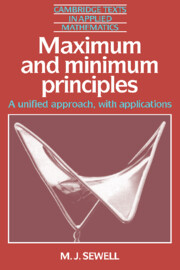3 - Upper and lower bounds via saddle functionals
Published online by Cambridge University Press: 12 October 2009
Summary
Introduction
This is the core of the book. We show how to construct upper and lower bounds in a number of representative infinite dimensional problems.
The approach is to generalize Theorem 1.6, which was proved for the finite dimensional case. The basic result is Theorem 3.4. We set the problems in a pair of infinite dimensional inner product spaces. We construct some simple tools which allow this setting to mimic the finite dimensional development in Chapters 1 and 2.
These tools include a straightforward but unfamiliar type of inner product space element (§3.2 (ii)), a pair of linear operators T and T* which are adjoint to each other in the true sense, not merely the formal sense (§3.3 (ii) and (iii)), and the gradient of a functional whose domain is an inner product space (§3.4(ii) and (iii)).
Application to differential equations with one type of mixed boundary conditions is explained by the detailed working of an example (§3.7) and the extension of similar methods to other cases is indicated in §§3.8–3.10. A connection with variational inequalities is mentioned in §3.11. We conclude (§3.12) with an account of equations containing a nonnegative operator, typically decomposable as T*T. These admit not only simultaneous bounds but also, in some cases, alternative pairs of such bounds not unlike those already indicated for networks in §2.8. This is one situation in which integral equations become prominent, as we illustrate for a wave scattering problem in fluid mechanics.
- Type
- Chapter
- Information
- Maximum and Minimum PrinciplesA Unified Approach with Applications, pp. 188 - 292Publisher: Cambridge University PressPrint publication year: 1987



